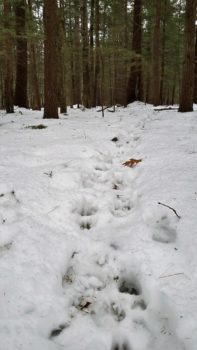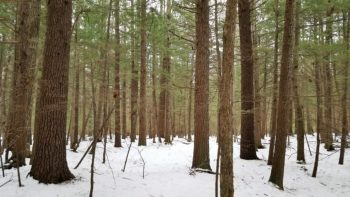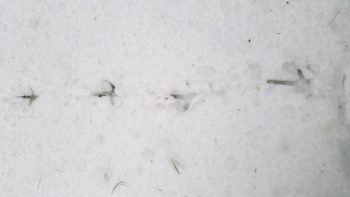Every walk in the woods ends up telling a story. It may be about the rough day you had at work, it may be about the amazing fall foliage you saw while walking, or it could be like a recent walk I took at Sewell Woods, in which it quickly became clear that the story was all about deer.
With the lates t snowfall nearly a week ago, there was plenty of time for all kinds of wildlife to leave tracks. Right out of the parking lot, I began seeing deer tracks following the trail. Deer and many other kinds of wildlife will walk on our trails, given the chance. Our big flat feet pack the snow down and create an easy walking surface. Of course, our trails won’t get wild animals to all the places they need to go to find food, water and safe places to sleep, so it wasn’t long before I started seeing well-trodden deer trails meandering off into the forest. The deer trails were nearly as packed as the human trails, and I noticed a lack of random deer tracks covering the forest floor. This was a first clue to me that I was in what wildlife biologists refer to as a deer wintering area, or a deer yard.
t snowfall nearly a week ago, there was plenty of time for all kinds of wildlife to leave tracks. Right out of the parking lot, I began seeing deer tracks following the trail. Deer and many other kinds of wildlife will walk on our trails, given the chance. Our big flat feet pack the snow down and create an easy walking surface. Of course, our trails won’t get wild animals to all the places they need to go to find food, water and safe places to sleep, so it wasn’t long before I started seeing well-trodden deer trails meandering off into the forest. The deer trails were nearly as packed as the human trails, and I noticed a lack of random deer tracks covering the forest floor. This was a first clue to me that I was in what wildlife biologists refer to as a deer wintering area, or a deer yard.
I started paying more attention to the forest structure as I walked the first part of the trail, called the Bruce Lincoln loop. As I got farther from the roadside, the habitat changed from a relatively mixed age forest to a mature conifer forest. The majority of the trees were tall and old, with almost no young trees growing up underneath. This told me that the forest canopy, or upper layer of evergreen needles (primarily hemlock and white pine, with some red spruce), was dense enough to shade the forest floor. It would also intercept some of the snow, making it easier for animals below to get around. This is the key to a deer yard. When winter closes in each year, if snow depths in the fields accumulate above 12 to 18 inches, deer begin to migrate to a deer yard. These are places that are apparently known by the elder deer, who pass this traditional knowledge on to younger deer. Snow depths inside a deer yard can be half as deep as out in the open. Moreover, when deer congregate inside a deer yard, they save energy when they stick to trails that they have all created, rather than punching in new trails all the time
If conditions stay severe, with deep snow, strong winds or exceptionally cold temperatures (as happened around the holidays), deer remain confined to the core of their winter habitat. It is a cruel irony that this habitat shelters the deer from the elements, but provides almost nothing in the way of food. Deer are forced to simply wait out the weather and hope that conditions change before starvation sets in, nibbling on twigs and lichen to fill their bellies but without providing the calories needed to warm their bodies indefinitely. With our January thaw, deer were able to break out of their core winter habitat and comb the surrounding forest for food, so it is difficult to know if Sewell Woods actually serves as a proper deer yard or if it is a feeding area around the edges, but the density of trails all over the property tells me that this 35-acre block of undeveloped woods is helping deer make it through the winter. You can be sure I’ll be back to explore again if the snow builds up again this winter.
I did see a variety of other wildlife tracks as I rounded the Albert Sewell Loop Trail and when I crossed the road and walked the Frith Farm Trail. Weasel, coyote, red and gray squirrel, mouse, and most interestingly, wild turkey tracks crossed and/or followed the hiking trail. There is absolutely nothing like a walk in the snowy woods to remind us that the lands conserved by Scarborough Land Trust, or any of a variety of other conservation groups working in the area, not only benefit people, but provide critical habitat for the full-time residents of the woods all around us.




